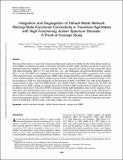Integration and Segregation of Default Mode Network Resting-State Functional Connectivity in Transition-Age Males with High-Functioning Autism Spectrum Disorder: A Proof-of-Concept Study
Author(s)
Arnold Anteraper, Sheeba; Patil, Kaustubh R.; Semwal, Meha; Goldin, Rachel L.; Furtak, Stephannie L.; Chai, Xiaoqian Jenny; Saygin, Zeynep M.; Biederman, Joseph; Joshi, Gagan; Gabrieli, John D. E.; Whitfield-Gabrieli, Susan; ... Show more Show less
Downloadbrain.2016.0483.pdf (1.068Mb)
PUBLISHER_POLICY
Publisher Policy
Article is made available in accordance with the publisher's policy and may be subject to US copyright law. Please refer to the publisher's site for terms of use.
Terms of use
Metadata
Show full item recordAbstract
The aim of this study is to assess the resting-state functional connectivity (RsFc) profile of the default mode network (DMN) in transition-age males with autism spectrum disorder (ASD). Resting-state blood oxygen level-dependent functional magnetic resonance imaging data were acquired from adolescent and young adult males with high-functioning ASD (n = 15) and from age-, sex-, and intelligence quotient-matched healthy controls (HCs; n = 16). The DMN was examined by assessing the positive and negative RsFc correlations of an average of the literature-based conceptualized major DMN nodes (medial prefrontal cortex [mPFC], posterior cingulate cortex, bilateral angular, and inferior temporal gyrus regions). RsFc data analysis was performed using a seed-driven approach. ASD was characterized by an altered pattern of RsFc in the DMN. The ASD group exhibited a weaker pattern of intra- and extra-DMN-positive and -negative RsFc correlations, respectively. In ASD, the strength of intra-DMN coupling was significantly reduced with the mPFC and the bilateral angular gyrus regions. In addition, the polarity of the extra-DMN correlation with the right hemispheric task-positive regions of fusiform gyrus and supramarginal gyrus was reversed from typically negative to positive in the ASD group. A wide variability was observed in the presentation of the RsFc profile of the DMN in both HC and ASD groups that revealed a distinct pattern of subgrouping using pattern recognition analyses. These findings imply that the functional architecture profile of the DMN is altered in ASD with weaker than expected integration and segregation of DMN RsFc. Future studies with larger sample sizes are warranted. Keywords: autism spectrum disorder; default mode network; resting-state fMRI
Date issued
2017-11Department
Massachusetts Institute of Technology. Department of Brain and Cognitive Sciences; McGovern Institute for Brain Research at MITJournal
Brain Connectivity
Publisher
Mary Ann Liebert Inc
Citation
Joshi, Gagan et al. “Integration and Segregation of Default Mode Network Resting-State Functional Connectivity in Transition-Age Males with High-Functioning Autism Spectrum Disorder: A Proof-of-Concept Study.” Brain Connectivity 7, 9 (November 2017): 558–573 © 2017 Mary Ann Liebert Inc
Version: Final published version
ISSN
2158-0014
2158-0022